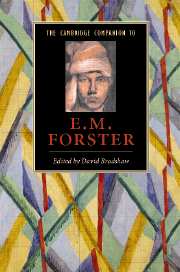Book contents
- Frontmatter
- Introduction
- 1 Forster’s life and life-writing
- 2 Bloomsbury and other values
- 3 Forster and England
- 4 Hellenism and the lure of Italy
- 5 Forster and the short story
- 6 Forster and the novel
- 7 Forsterian sexuality
- 8 Forster and women
- 9 A Room with a View
- 10 Howards End
- 11 Maurice
- 12 A Passage to India
- 13 Forster and modernism
- 14 Forster as literary critic
- 15 Filmed Forster
- 16 Postcolonial Forster
- Further reading
- Index
- Series List
7 - Forsterian sexuality
Published online by Cambridge University Press: 28 September 2007
- Frontmatter
- Introduction
- 1 Forster’s life and life-writing
- 2 Bloomsbury and other values
- 3 Forster and England
- 4 Hellenism and the lure of Italy
- 5 Forster and the short story
- 6 Forster and the novel
- 7 Forsterian sexuality
- 8 Forster and women
- 9 A Room with a View
- 10 Howards End
- 11 Maurice
- 12 A Passage to India
- 13 Forster and modernism
- 14 Forster as literary critic
- 15 Filmed Forster
- 16 Postcolonial Forster
- Further reading
- Index
- Series List
Summary
I should have been a more famous writer if I had written or rather published more, but sex has prevented the latter.
(Forster, diary entry, 31 December 1964, quoted LC, p. xiv)'What do you want for yourself?' When D. H. Lawrence asked Forster this question, early in 1915, the writers had known each other barely a week. They had met and talked amiably just a few days earlier, at a dinner party hosted by Lady Ottoline Morrell. Books and letters soon crossed in the mail, followed by an invitation for Forster to stay with Lawrence at Greatham, Sussex. Both men had by this point won acclaim (Forster rather more than Lawrence) and each hoped to cement what he thought would be an important friendship. But the visit did not go well. On the second day, Lawrence launched into a tirade about Forster's work, life, and philosophy that ended, hours later, with Forster asking plaintively, 'How do you know I'm not dead?'
Readers might prefer to draw a veil over this exchange, convinced that it points more to Lawrence's aggression than to Forster's reticence. But the exchange has different value, I believe, in showing how Forster sometimes tried to transpose desire into nonsexual forms, including literary depictions of marriage and what he called 'democratic affection'. This chapter will examine the creative tensions informing this transposition and its implications for readers and critics, especially those wanting to assess sexuality's influence on Forster's life and work. For with startling perception, Lawrence broached a set of issues, sexual and creative, that Forster had huddled defensively and privately berated himself for, and throughout the 1910s could find no simple way to resolve.
- Type
- Chapter
- Information
- The Cambridge Companion to E. M. Forster , pp. 104 - 119Publisher: Cambridge University PressPrint publication year: 2007
- 2
- Cited by



